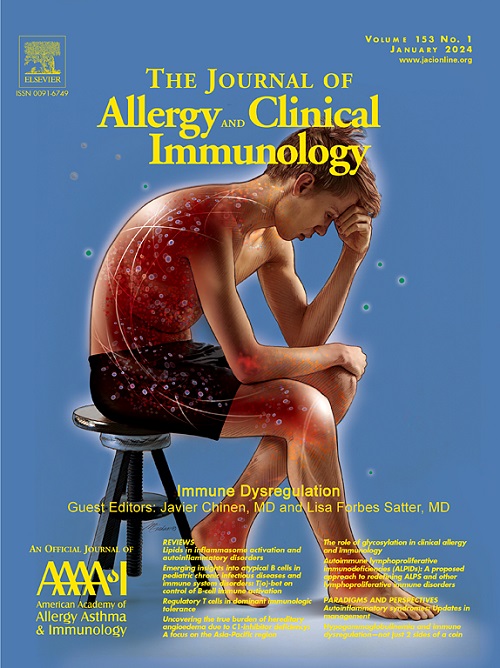Small proline-rich protein 2A drives epithelial remodeling in eosinophilic chronic rhinosinusitis with nasal polyps via SAA2 upregulation
IF 11.2
1区 医学
Q1 ALLERGY
引用次数: 0
Abstract
Background
Eosinophilic chronic rhinosinusitis with nasal polyps (eCRSwNP) is a severe subtype of chronic rhinosinusitis characterized by eosinophilic inflammation, type 2 immune responses, and tissue remodeling in the sinonasal mucosa.
Objective
We sought to identify genes contributing to eCRSwNP pathogenesis and elucidate their roles in epithelial dysfunction and tissue remodeling.
Methods
Transcriptome sequencing was conducted on nasal tissues from patients with eCRSwNP, noneosinophilic CRSwNP (neCRSwNP), and healthy controls and from a CRSwNP mouse model with small proline-rich protein 2A knockout (Sprr2a−/−) mice. Epithelial-mesenchymal transition (EMT) was examined in the CRSwNP mouse model and air-liquid interface culture system with nasal epithelial cells.
Results
Transcriptomic analysis revealed that SPRR2A expression was significantly elevated in eCRSwNP nasal tissues compared with neCRSwNP and healthy controls. High SPRR2A expression correlated with increased eosinophil infiltration, epithelial thickness, and IL-13 levels. In the CRSwNP mouse model, Sprr2a−/− mice displayed reduced epithelial thickness, fewer nasal polyps, lower IL-4 and IL-13 levels, and attenuated EMT. In vitro, nasal epithelial cells from Sprr2a−/− mice demonstrated reduced EMT markers and preserved barrier integrity. Further transcriptomic analysis identified serum amyloid A3 (Saa3) as a downstream mediator of SPRR2A. Saa3 expression was reduced in Sprr2a−/− mice, whereas serum amyloid A2 (SAA2 [human]) was upregulated in eCRSwNP compared with neCRSwNP and healthy controls and positively correlated with SPRR2A levels. In air-liquid interface cultures, Saa3 induced EMT and barrier dysfunction and increased IL-6, thymic stromal lymphopoietin, IL-33, and TGF-β1 production.
Conclusions
These findings suggest that SPRR2A promotes eosinophilic inflammation and tissue remodeling via SAA2, highlighting the SPRR2A-SAA2 axis as a potential therapeutic target in eCRSwNP.
小脯氨酸富蛋白2A通过SAA2上调驱动嗜酸性慢性鼻窦炎伴鼻息肉的上皮重塑。
背景:嗜酸性慢性鼻窦炎伴鼻息肉(eCRSwNP)是一种严重的慢性鼻窦炎亚型,其特征是嗜酸性炎症、2型(T2)免疫反应和鼻粘膜组织重塑。目的:我们试图鉴定与eCRSwNP发病机制有关的基因,并阐明它们在上皮功能障碍和组织重塑中的作用。方法:对eCRSwNP患者、非嗜酸性CRSwNP (neCRSwNP)患者和健康对照组以及Sprr2a基因敲除的CRSwNP小鼠模型(Sprr2a-/-)小鼠的鼻腔组织进行转录组测序。用CRSwNP小鼠模型和气液界面(ALI)培养系统检测鼻上皮细胞上皮间充质转化(EMT)。结果:转录组学分析显示,与neCRSwNP和健康对照组相比,SPRR2A在eCRSwNP鼻组织中的表达显著升高。SPRR2A高表达与嗜酸性粒细胞浸润、上皮细胞厚度和IL-13水平增加相关。在CRSwNP小鼠模型中,Sprr2a-/-小鼠表现出上皮厚度减少,鼻息肉减少,IL-4和IL-13水平降低,EMT减弱。在体外,Sprr2a-/-小鼠的鼻上皮细胞显示出EMT标记物减少和屏障完整性保持。进一步的转录组学分析发现血清淀粉样蛋白A3 (Saa3)是SPRR2A的下游介质。Saa3在Sprr2a-/-小鼠中的表达降低,而SAA2(人)在eCRSwNP中与neCRSwNP和健康对照组相比表达上调,且与Sprr2a水平呈正相关。在ALI培养中,Saa3诱导EMT、屏障功能障碍,并增加IL-6、TSLP、IL-33和TGF-β1的产生。结论:这些发现表明SPRR2A通过SAA2促进嗜酸性粒细胞炎症和组织重塑,突出了SPRR2A-SAA2轴作为eCRSwNP的潜在治疗靶点。
本文章由计算机程序翻译,如有差异,请以英文原文为准。
求助全文
约1分钟内获得全文
求助全文
来源期刊
CiteScore
25.90
自引率
7.70%
发文量
1302
审稿时长
38 days
期刊介绍:
The Journal of Allergy and Clinical Immunology is a prestigious publication that features groundbreaking research in the fields of Allergy, Asthma, and Immunology. This influential journal publishes high-impact research papers that explore various topics, including asthma, food allergy, allergic rhinitis, atopic dermatitis, primary immune deficiencies, occupational and environmental allergy, and other allergic and immunologic diseases. The articles not only report on clinical trials and mechanistic studies but also provide insights into novel therapies, underlying mechanisms, and important discoveries that contribute to our understanding of these diseases. By sharing this valuable information, the journal aims to enhance the diagnosis and management of patients in the future.

 求助内容:
求助内容: 应助结果提醒方式:
应助结果提醒方式:


